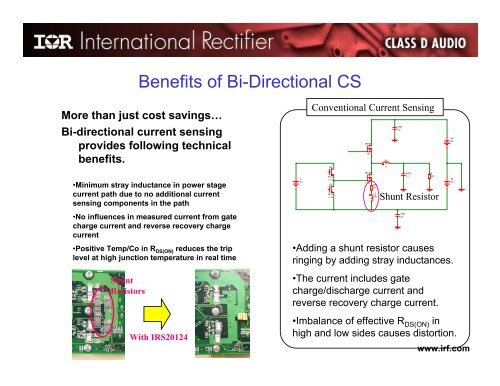Designing Practical High Performance Class D Audio Amplifier
Designing Practical High Performance Class D Audio Amplifier
Designing Practical High Performance Class D Audio Amplifier
You also want an ePaper? Increase the reach of your titles
YUMPU automatically turns print PDFs into web optimized ePapers that Google loves.
Benefits of Bi-Directional CS<br />
More than just cost savings…<br />
Bi-directional current sensing<br />
provides following technical<br />
benefits.<br />
Conventional Current Sensing<br />
100n<br />
C2<br />
IRF530<br />
Q1<br />
22u<br />
Q4<br />
L1<br />
50<br />
V2<br />
•Minimum stray inductance in power stage<br />
current path due to no additional current<br />
sensing components in the path<br />
5<br />
V1<br />
W=1u<br />
L=1u<br />
Q3<br />
W=1u<br />
L=1u<br />
IRF530<br />
Q2<br />
470n<br />
C1<br />
20m<br />
R1<br />
L2<br />
50n<br />
Shunt Resistor<br />
8<br />
R2<br />
50<br />
V3<br />
•No influences in measured current from gate<br />
charge current and reverse recovery charge<br />
current<br />
•Positive Temp/Co in R DS(ON) reduces the trip<br />
level at high junction temperature in real time<br />
Shunt<br />
Resistors<br />
With IRS20124<br />
•Adding a shunt resistor causes<br />
ringing by adding stray inductances.<br />
•The current includes gate<br />
charge/discharge current and<br />
reverse recovery charge current.<br />
•Imbalance of effective R DS(ON) in<br />
high and low sides causes distortion.<br />
100n<br />
C3<br />
www.irf.com

















